The purpose of this post is to demonstrate to homeschooling parents, community members, and colleagues within the teaching fraternity, the reason why the change in teaching strategies of mathematics in primary education has occurred. Why the Board of Studies NSW (2002, p. 6), believes that mathematics teaching should have a practical application, and provide opportunities for creativity, challenge and leisure, and why teaching mathematics should support concurrent learning across other key learning areas and build a foundation for future mathematics education.
This post will also examine the reason why children learn many mathematical concepts through play and games, that hands-on experiences in real life situations are extremely important, and there are numerous ways and means of teaching children how to grasp mathematical concepts. It will also clarify why teaching mathematics from a textbook or learning times tables by rote is easy enough to do, but that it is not helping children to understand the mathematical concept of how and why it works. I believe homeschooled children are at an advantage to grasp this concept fully.
Finally, this post will demonstrate what children are learning and why, so that mathematics will no longer be tedious, frustrating and fearful or cause a life-long distaste for anything mathematical. It will also illustrate that the process of collaboration through play will help children gain a combination of social and academic skills.
Although my explanations are best suited for those living and schooling children in NSW, it is much the same in other States of Australia and possibly similar in other countries. In order for me to do my research properly, I have chosen NSW as my base for this write-up.
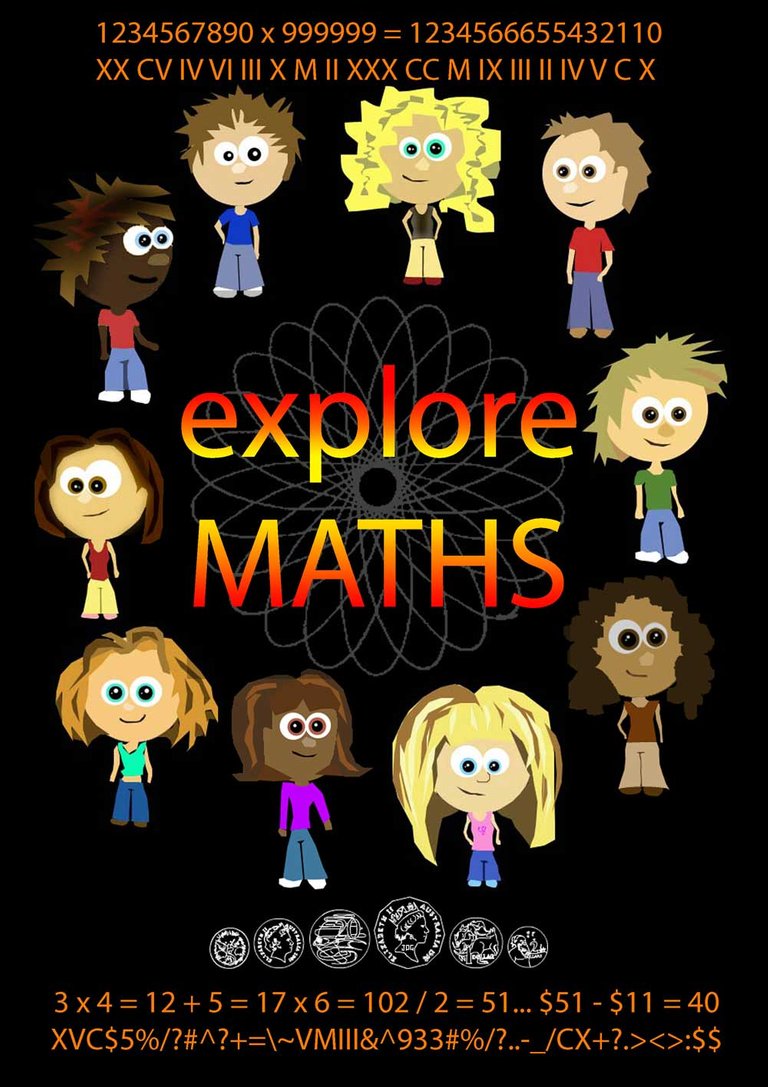
Source: Teaching Treasures Publications
The Maths Strands
First of all, the following will identify the key principles and ideas that explain the approach to the mathematics curriculum and related teaching practices.
The essential content for learning mathematics is organized into six strands. One process strand, Working Mathematically, and five content strands, Number, Patterns and Algebra, Data, Measurement, and Space and Geometry (fig. 1). Working Mathematically encompasses a set of five key processes that are embedded into the other five strands through the content. Because of these key processes, children are able to engage in genuine mathematical activities and to develop flexible and creative skills to become effective users of mathematics.
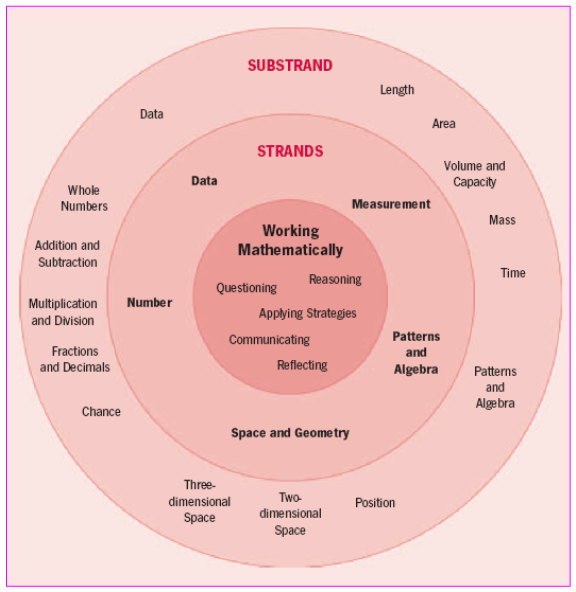
Fig. 1 (Board of Studies NSW 2002)
How Children Learn
Mathematics encompasses the calculated decisions people make on a daily basis and forms the foundation for just about everything they do in life. Children learn through the processes of seeing, hearing, communicating and participating in the many facets of mathematics while making calculated decisions and solving problems. They learn best through active participation and collaborating with others using play and real life experiences.
On account of this fact, in primary school these are accomplished through strategies and teaching practices such as cooperation, participation, meaningful and practical activities. According to Reys, Lindquist, Lambdin, and Smith (2009) these also include physical hands-on experiences, active decision making, communication and collaboration, and sharing and helping. As teachers we agree with Reys et al. (2009) in that the key principles and ideas behind this is for children to question, apply strategies, communicate, reason, and reflect on their learning (fig. 2).
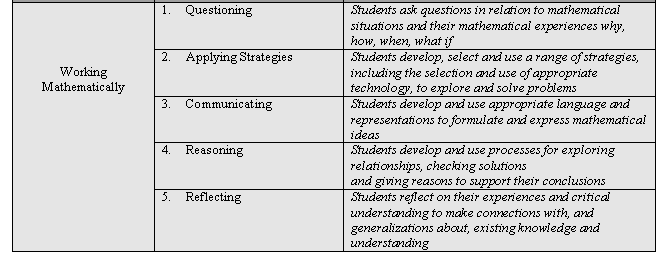
Fig. 2 (Reys et al. 2009)
21st Century Curriculum
In order for children to learn effectively and be able to participate and collaborate with their peers, teachers formulate the mathematics curriculum to include and connect activities with numbers, patterns, algebra, data, measurement, space and geometry.
Materials used include computers, calculators, charts, posters, games, toys, props and anything else that would allow children to physically touch, manipulate or pull apart. This type of twenty-first century curriculum allows children to be active learners instead of passive learners, and helps them to understand the reason why, how and what they are learning across several learning outcomes (fig. 3).
Fig. 3 (Booker et.al 2004, pp. 1-31)
Approaches & Practices
Decisions on the approaches and practices in public schooling is done by the Board of Studies, but in a homeschool setting it is the parent. Therefore great responsibility falls upon parent-teachers to deliver such a curriculum as to obtain the best possible learning experiences and results for their children.
The Board of Studies NSW (2002, p.14) believes, and stresses the importance, that “teachers need to acknowledge the learning that children bring to school, and plan appropriate learning experiences that make connections with existing mathematical understanding.”
As teachers we recognize the educational objectives, guidelines and recommendations which are set by the Board of Studies NSW (2002) and “was established in 1990 to serve government and non-government schools in the development of school education for Years K-12, providing educational leadership by developing quality curriculum” (fig. 4). Homeschooling parents should take note of these standards in order to achieve superb outcomes for their children.
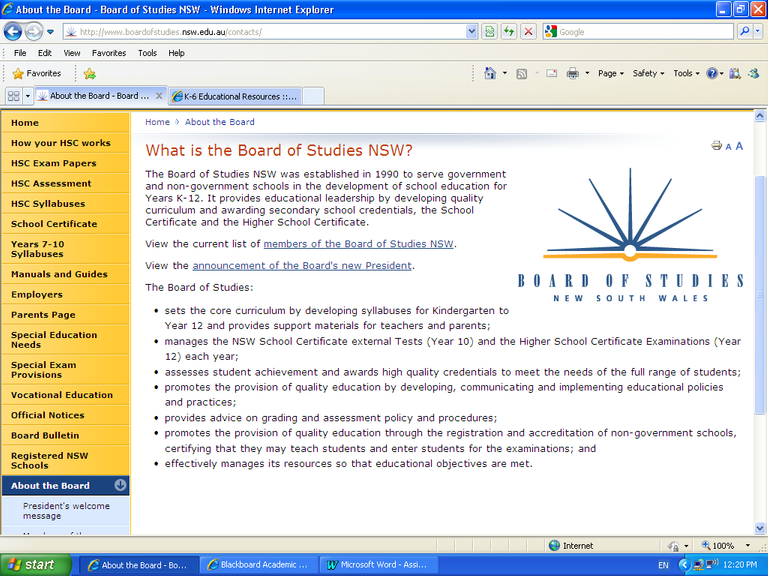
Fig. 4 (Board of Studies NSW 2009)
The Board of Studies NSW (2002), teachers, and homeschooling parents realize that children start developing mathematical understanding well before they start school since mathematics is a part of everyday life. Therefore, educational opportunities should engage and challenge all students to maximize their individual talents and capabilities for lifelong learning.
Educational opportunities should also enable all students to develop positive self-concepts and their capacity to establish and maintain safe, healthy and rewarding lives. In addition, all students should be prepared for effective and responsible participation in their society, taking account of moral, ethical and spiritual considerations.
Therefore teachers and parents should continue to encourage and enable all students to enjoy learning, and to be self-motivated, reflective, competent learners who will be able to take part in further study, work or training. Finally it is essential to promote a fair and just society that values diversity and promotes continuity and coherence of learning and facilitates transition between primary and secondary schooling (The Board of Studies NSW 2002, p.6).
Because the Board of Studies NSW (2002), teachers, and parents believe that mathematics is important (fig. 5), learning requirements are set for each stage of primary school. At every stage students should be provided with opportunities for creativity, challenge and leisure.
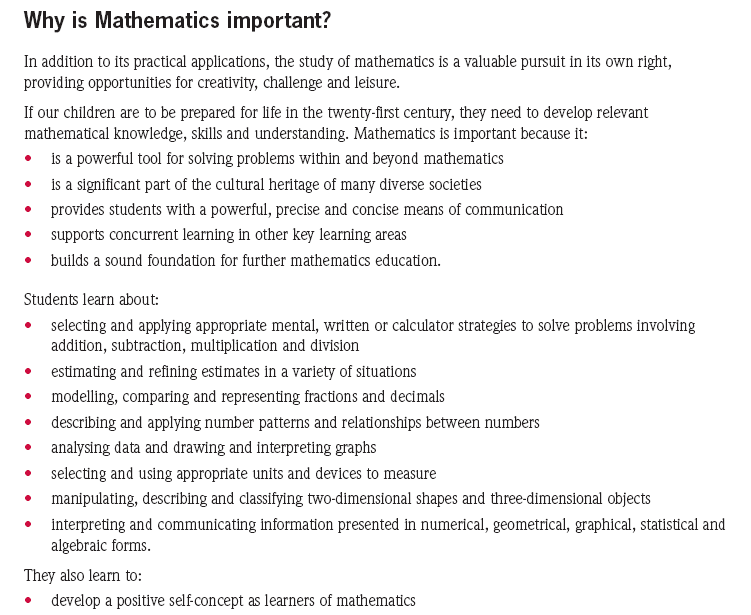
Fig. 5 (Board of Studies NSW 2002)
Figure 6 below, shows that 20% of classroom time is spend on teaching children mathematics. Therefore, in order to avoid children from loosing their enthusiasm for learning mathematics, many hands-on activities, games and props are used to teach mathematics.

Fig. 6 (Board of Studies NSW 2002)
Booker, Bond, Sparrow, and Swan in Teaching Primary Mathematics (2004) state that "learning is also a social activity, and both the mathematics and the manner in which it is learned are influenced by the way children interact with each other and with their teachers."
They continue to explain that once it was sufficient to simply know the procedures of how to add, subtract, multiply and divide in order to gain employment. However, due to technology many of these procedures are now carried out by machines and as teachers and homeschooling parents we realize that children now need to “understand the thinking on which processes are built so that they might be adapted to new and novel applications” (Booker et al. 2004, p. 1).
Reys et al. (2009) believe that everybody is able to learn the mathematical study of patterns and relationships and that mathematics is a way of thinking, and art, and a language but not everybody is capable of learning it at the same level.
We now understand that each child learns at a different rate and has different learning abilities. For some, fractions may be a simple task, while for others it is almost impossible to grasp this process. Because of the huge swing in mathematical knowledge in our technological world, a new demand and responsibility has been placed on the teaching fraternity, and that includes homeschooling families. We all need to use teaching and training tools necessary to teach children fresh skills, which are needed for success in the real world (Reys et al. 2009, pp. 1-13).
According to Teaching Treasures Publications (2009) all teaching-training tools and supplies should be designed “to bring out the treasures in all children and encourage enjoyment in learning, research skills, thought processes, individual and collaborative learning” (Teaching Treasures 2009).
They also believe this is necessary to change our previous passive teaching and learning into our twenty-first century of active teaching and learning, which is partially done through play and games.
Specific example of the approach in the space/geometry & measurement strands.

Fig. 6 (Board of Studies NSW 2002)
Example of Space and Geometry Stage 2
The following two dimensional shapes and tessellation theme activity demonstrates Working Mathematically through active learning, physical participation and collaboration using questioning, reasoning, applying strategies, communicating and reflecting.
A theme is used here to demonstrate how teachers build upon student’s previous learned knowledge over the course of one week. Each lesson runs approximately one hour. The learning outcome follows each lesson for the benefit of the audience.
Example of Activity Year 4: 2-D Shapes & Tessellation Theme
Day 1 – Shapes and their names
Step 1:
A. Groups of 4 are formed and each student is given the worksheet ‘Write the Name of Each Shape’ and asked to complete it (see fig. 7).
B. Within their group, they are encouraged to help each other complete the worksheet.
C. Upon completing the worksheet, each group is then to find and record shapes and objects used in their environment such as in buildings, parks, schools, shops or their home. These can be squares, rectangles, circles, and triangles for example.
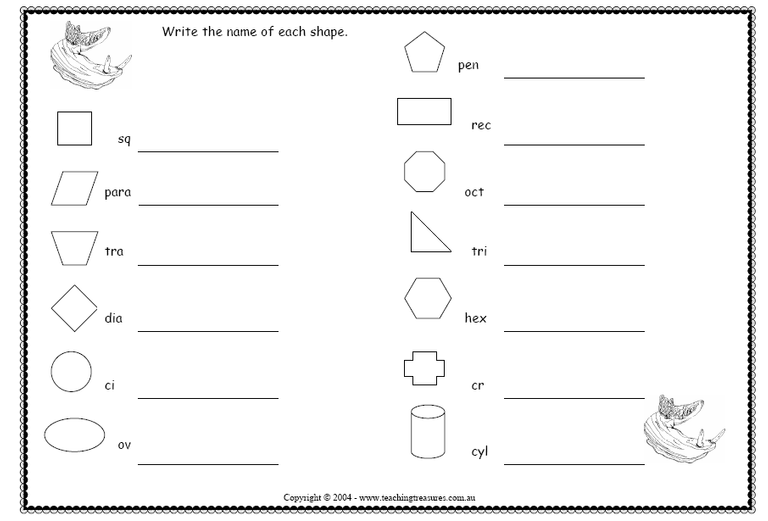
Fig. 7 (Teaching Treasures 2004)
Step 2:
Once students have found and recorded their shapes they are to discuss, with each other and their teacher, why some shapes and objects are used more than others.
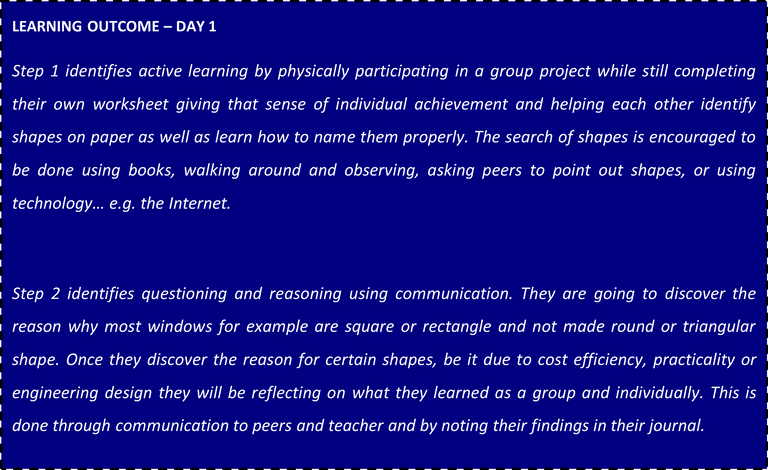
Day 2 – Tessellation
Step 1:
The second lesson is on day two. First of all a quick discussion takes place reinforcing what was learned the previous day regarding shapes and their names.
The students are then presented with a new word… tessellation, of which the teacher will explain the meaning verbally and by providing pictures from books, magazines, posters and the Internet as examples.
Each group of students are then to find their own examples and draw tessellating shapes found in the community (e.g. patterns on pavements, windows in buildings, desks in classroom) and also use the Internet to locate examples of tessellating shapes.
Step 2:
They are asked to go online and have a play with a tessellation activity from the ‘National Library of Virtual Manipulatives’ (fig. 8)
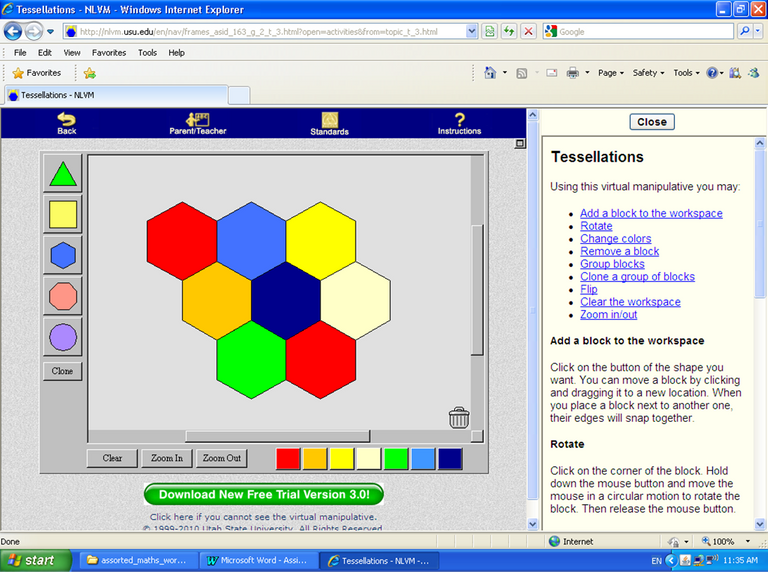
Fig. 8 (National Library of Virtual Manipulatives 2010)
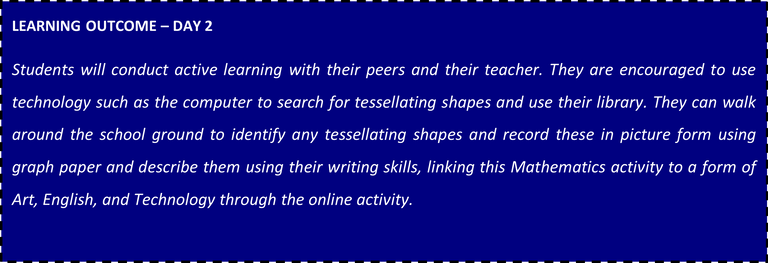
Day 3 – Tessellating one square meter
Step 1:
Day three first takes a quick revision on what was learned on day 1 (shapes and their proper names) and day 2 (the meaning of tessellation).
Step 2:
A. Each group is to find a vacant area within the classroom of 1 square meter and mark it with tape on the floor.
B. They are given a tessellating shape such as a square and asked to duplicate the shape as many times as needed in order to fill their entire square meter.
C. They will need to count how many times their shape fits within the square meter.
Again this is done as a collaboration project within their group and the outcome is recorded in their notebooks. Should they not line up the squares, then there is opportunity to discuss the half spaces left within their square, which can be filled by cutting some squares in half or by changing the pattern within their square meter. Providing hexagons or triangles instead of squares can increase the challenge and difficulty level.
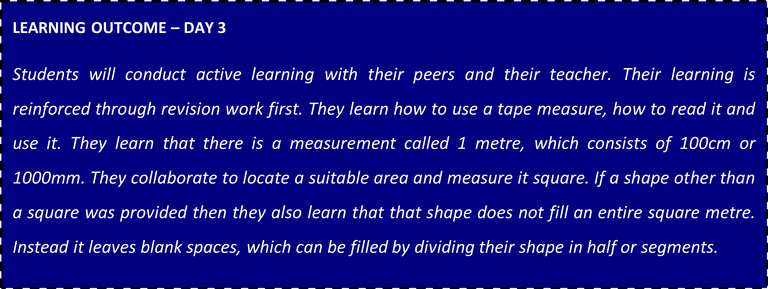
Day 4 – Horizontal and Vertical Line Symmetry
Step 1:
A. Revision is carried out first thing and reinforces the learning outcomes of shapes and their proper names, tessellation, and how they achieved to fit their tessellating shapes within a certain measured area.
B. Students are then introduced to line symmetry where shapes can flip, slide or turn to form patterns and shapes.
C. This project involves the exploring of patterns using a computer and discovering the many patterns and shapes they can produce through manipulating positions and orientations of two-dimensional shapes after transformations such as reflections, rotations, and translations.
This is done through a collaboration project using an online activity from HealMedia(fig 9)
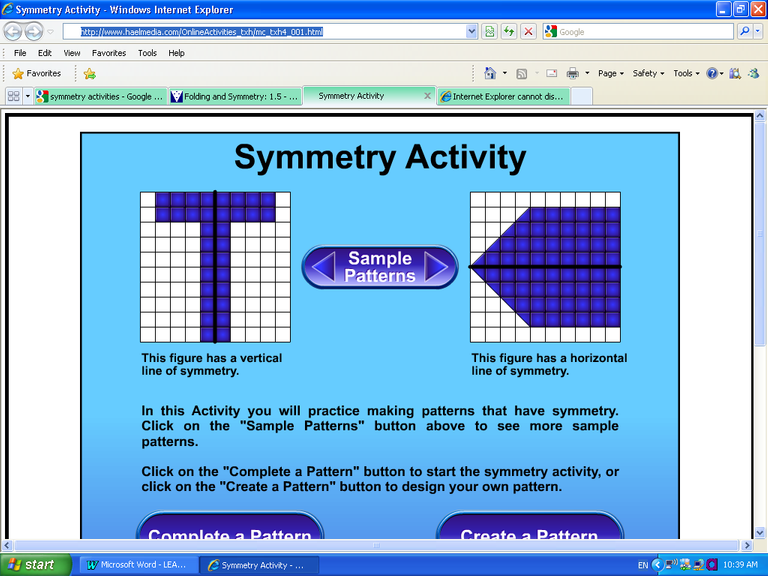
Fig. 9 (HealMedia 2008)
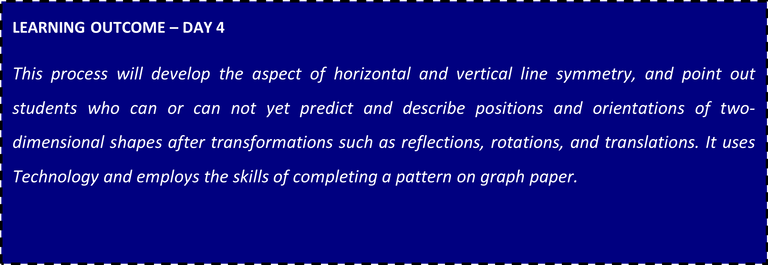
Day 5 - Reflection
Step 1:
On the last day there will be revision work as to what was taught and learned through class discussion. Student’s critical understanding of what was learned will come to light through this final but most important process of communicating and reflecting on the learning and teaching processes and outcomes.
Step 2:
Students are asked to sketch the shapes they have remembered and write their proper names on a whiteboard for example. They can also display their worksheets by hanging them on the wall. The tape measure will be discussed and one meter can be measured across the floor, windowsill, desk or wall to simply reinforce how long one meter is and the fact that it contains 100 cm or 1000 mm.
This concludes this theme lesson in 2-D Shapes and Tessellation.
Students have now identified various shapes, their proper names, tessellation and line symmetry. By using this teaching method and practice of the processes of questioning, reasoning, applying strategies, communicating and reflecting on student learning with their peers and their teacher, they have used active, instead of passive participation.
This method covers several learning areas and outcomes such as Art, English, and Technology, and of course Mathematics including the outcomes of space/geometry and measurement. The covering of several learning outcomes across different learning areas is by far the best method of teaching children, which is active participation, employing research skills, thought process, and individual and collaborative learning.

In Conclusion
This report concludes the presentation of twenty-first century mathematics teaching to parents, community members and colleagues within the teaching fraternity. It has explained the reasons why changes in teaching strategies of mathematics in primary school have occurred and why it is requisite to twenty-first century education. It also testifies that teaching mathematics should support concurrent learning across other key learning areas in order to build a solid foundation for future mathematics education.
The theme of 2-D Shapes and Tessellation has proven that children learn through the processes of seeing, hearing, communicating and participating in the many facets of mathematics while making calculated decisions and solving problems. The best teaching methods and practices of these processes according to Reys et al. (2009) and teachers alike are accomplished through exercising cooperation, participation, meaningful and practical activities, physical hands-on experiences, active decision making, communication, collaboration, and sharing and helping within the classroom.
References:
Board of Studies NSW. (2002). Mathematics K-6. Parent Support Document.
Introducing the Mathematics K–6 Syllabus to Parents and School Community Members. Published by Board of Studies, Sydney NSW 2001. Retrieved November 12, 2009 from: http://www.boardofstudies.nsw.edu.au – Online Document
Booker, G., Bond, D., Sparrow, L., and Swan, P. (2004). Teaching Primary
Mathematics. Pearson Australia. Frenchs Forrest NSW Australia - Book
HealMedia. (2008). Retrieved January 12, 2020.
National Library of Virtual Manipulatives, NLVM. (2009). Retrieved December 15,
2009 from: http://nlvm.usu.edu/en/nav/category_g_2_t_3.html
Reys, R., Lindquist, M., Lambdin, D., and Smith, N. (2009). Helping Children
learn Mathematics. John Wiley and Sons, Inc. Danvers USA - Book
Teaching Treasures Publications. (2022). Retrieved December 8, 2009 from:
http://www.teachingtreasures.com.au – Web Page
Images:
Outcomes Circle. [Image] (2002). Board of Studies NSW. Mathematics K-6.
Parent Support Document. Introducing the Mathematics K–6 Syllabus to Parents and School Community Members. Published by Board of Studies, Sydney NSW 2001.
Pie. [Image] (2002). Board of Studies NSW. Mathematics K-6.
Parent Support Document. Introducing the Mathematics K–6 Syllabus to Parents and School Community Members. Published by Board of Studies, Sydney NSW 2001.
Symmetry. [Image] (2009). HealMedia. (2008)
Tessellation. [Image] (2009). National Library of Virtual Manipulatives, NLVM. (2009).
What is the Board of Studies. [Image] (2002). Board of Studies NSW. Mathematics K-6. Parent Support Document. Introducing the Mathematics K–6 Syllabus to Parents and School Community Members. Published by Board of Studies, Sydney NSW 2001.
Why is mathematics Important. [Image] (2002). Board of Studies NSW.
Mathematics K-6. Parent Support Document. Introducing the Mathematics K–6 Syllabus to Parents and School Community Members. Published by Board of Studies, Sydney NSW 2001.
Write the Name of Each Shape [Image] (2009). Teaching Treasures Publications. Workbook Ages 8-9.
Bibliography:
Bandura, A. (1988). Organizational Application of Social Cognitive Theory.
Australian Journal of Management, 13(2), 275-302. Education YouTube.
Curriculum Corporation. (2009). National Literacy and Numeracy Testing 2008.
Education Act New South Wales Consolidated Acts. (1990).
http://www.austlii.edu.au/au/legis/nsw/consol_act/ea1990104
Mathematics Education Research Group of Australasia 2009 (MERGA).
Retrieved August 3, 2022 from: http://www.merga.net.au/ – Web Page
Naplan Online. (2022). National Assessment Program-Literacy and Numeracy.
National Council of Teachers of Mathematics 2009.
from: http://illuminations.nctm.org Web Page.
The Australian Association of Mathematics Teachers. (2009). (AAMT). http://www.aamt.edu.au/
Images and written content is my own unless otherwise specified or referenced.
@ingridontheroad
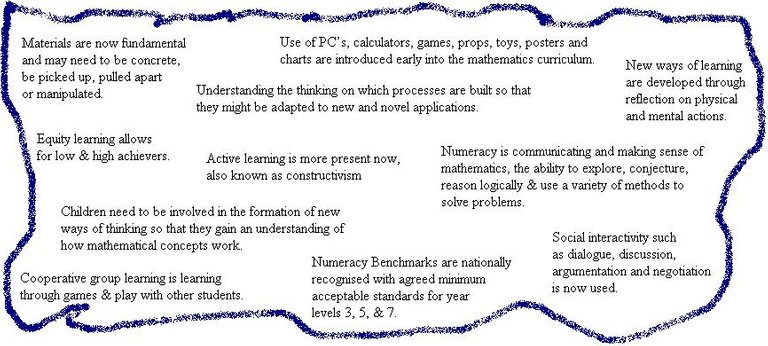
Congratulations @ingridontheroad! You have completed the following achievement on the Hive blockchain and have been rewarded with new badge(s):
Your next target is to reach 100 upvotes.
You can view your badges on your board and compare yourself to others in the Ranking
If you no longer want to receive notifications, reply to this comment with the word
STOPTo support your work, I also upvoted your post!
Check out the last post from @hivebuzz:
Support the HiveBuzz project. Vote for our proposal!
The teaching and learning of mathematics in some part of Africa is nothing to write home about, and I even wonder the future of our next generation, we use to say that children are the future leaders, but when the future has not been paid attention to and has been neglected,then the future will suffer. this is because many primary school do not even have teacher talk less of having an instructional materials not only in mathematics but also in other subjects. My concern is, if our educational systems are bad, parents should take up the responsibility in helping their children to learn mathematics and other science related subjects with the available materials
@Ingridontheroad
Feel free to read my other post too. Teach Mathematics and entertain your students while they're learning the concepts of Mathematics. https://peakd.com/hive-199420/@ingridontheroad/mathmagic-land
Absolutely, parents should teach their children. Not always possible if parents are illiterate or working. It's frightening the standard differences in different countries.